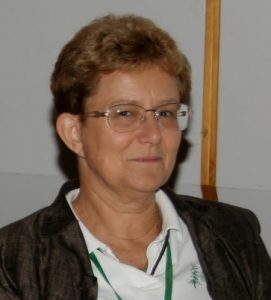
 INTERVIEW with keynote speaker Dr. Hojka Kraigher,
INTERVIEW with keynote speaker Dr. Hojka Kraigher,
Slovenian Forestry Institute, SLOVENIA
Keynote Plenary Session 2
Friday, 22 September, 10:30 – 12:00
Rolf Böhme Saal (Konzerthaus Freiburg)
“Hidden biodiversity and forest dynamics”
By Bob Burt
IUFRO Science Writer
Forest dynamics have been described as changes in stand structure, species composition, and species interactions with disturbance and environment over a range of spatial and temporal scales.
What is important to remember about that, said Dr. Hojka Kraigher, a keynote speaker at the IUFRO 125th Anniversary Congress in Freiburg, is that “forest dynamics are driven by – and drive – biodiversity.”
“Dynamics of forest ecosystems depend on the biodiversity of their constituents, at different scales in time and space, and are affected strongly by environmental changes. Among the latter, climate change – although predictions include many uncertainties – may drastically affect the distribution of forests at global, national, regional and local scales,” she added.
And it is not only the visible biodiversity that is important. “Hidden biodiversity, such as below-ground and genetic diversity, matters. It contributes to forest dynamics and provides channels through which we can manage the potential for forest adaptability,” she said.
Her keynote address is entitled: Hidden Biodiversity and Forest Dynamics.
Forest research, innovation and development (RID) is addressing ways to respond to the changing forests to support their sustainability
But caring properly for that hidden biodiversity calls for a strategy that includes strong RID and international collaboration in specific areas, she added.
“Therefore trans- inter- and multi-disciplinary RID, supporting excellence in science, with freedom to choose research priorities, is a strategy for future forestry and forests,” Dr. Kraigher said.
Forest research needs to be identified and prioritized as a research area unto itself, she said. She favors a bottom-up approach to research priorities based on specific issues – in this case, forest-related – that arise in the field and have to be addressed.
In her experience, she said, forest research often is lost within a research regime that attempts to be all things to all people.
She said she understands the reasoning behind the communal research approach of the European Research Area (ERA). “The research community within isolated countries is often too small, the critical number of researchers per subject or field of research can only be reached with international collaboration, etc.,” she said.
But she feels forest science within the ERA, “is a minor player. In many instances projects addressing forest issues are wrapped in only one or two project calls/projects inside two main fields within the Societal Challenges (SC)’ programme in Europe – SC2: Food security, sustainable agriculture and forestry, marine and maritime and inland water research and the bioeconomy; and SC5: Climate action, environment, resource efficiency and raw materials.”

Scaling drawn by Marco Bajc, SFI
In her opinion, “hidden biodiversity – genetic diversity as the fundamental level that forms the basis of future adaptability, and soil biodiversity as the basis for forest ecosystem functioning – can only be studied if it is dressed in the terminology of agriculture and animal husbandry.
“That can’t fully address all forest issues. There isn’t enough focus.”
While the ERA is most familiar to her, she uses it only as an example, she said. The same type of research framework is also used in other areas of the world and similarly diminishes the importance of forest research.
Dr. Kraigher said the soil diversity and genetic diversity communities that her presentation most specifically addresses are already collaborating in many areas and should be quite receptive to her speech.
But, she added, some may still be surprised by the inter-relationships between the roles of genetic and below-ground diversity on forest ecosystem functioning and on research results linking them.
Dr. Kraigher is Senior Scientist at the Slovenian Forestry Institute; and Head of the Department for Forest Physiology and Genetics; Head of the Research Program Forest Biology, Ecology and Technology; and Assoc. Professor of Botany at University of Ljubljana. Her expertise is in physiology and ecology of forest trees and mycorrhiza, and in conservation of forest genetic resources.
Come to the keynote plenary session http://iufro2017.com/scientific-sessions/
or follow it on live stream http://iufro2017.com/livestream/
IUFRO 125th Anniversary Congress – Interconnecting Forests, Science and People
The September 18-22 Congress in Freiburg will celebrate IUFRO’s 125th anniversary. Founded in 1892 in Eberswalde Germany, IUFRO has grown to unite more than 15,000 scientists (who cooperate in IUFRO on a voluntary basis) in almost 700 member organizations in more than 120 countries.
http://iufro2017.com/
IUFRO promotes global cooperation in forest-related research and enhances the understanding of the ecological, economic and social aspects of forests and trees. It disseminates scientific knowledge to stakeholders and decision-makers and contributes to forest policy and on-the-ground forest management.
http://www.iufro.org/

Leave a Reply